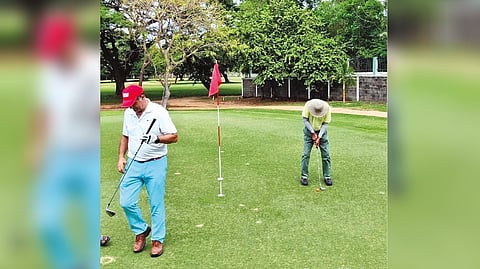

CHENNAI: RECENTLY, Twitter was abuzz with the news of a 77-year-old golfer punching his 84-year-old playing partner in the face, reportedly for asking him to follow putting etiquette on the green.
Although the incident occurred on April 29, on the De La Vista Golf Course in San Marino Drive, Florida, the post went viral only recently.
Closer home in Chennai, the incident led to a number of debates, with fellow golfers regaling one another with instances of transgressions by one party or the other on many occasions, all thankfully ending with handshakes after heated arguments.
“Golfing etiquette”, the one aspect that makes the sport an enjoyable experience, is actually easy to bring to play, but not always.
Speed up, slow down: From getting on to a tee box, to reaching the green, rules are in play, but golf is also governed by etiquette: of being sensitive to the needs of the player playing with you, behind your group, and the group crossing your path. First off, polite conversation is an art and is generally accepted, but not when one is setting up to play the ball.
How you walk and where you walk are as important as when you start walking. One does not walk behind another player who is addressing his ball. This could be in a radius of 30 feet in any direction.
Often, one finds a player in a group who is in a hurry and starts walking to his ball even as others behind him are playing. This is acceptable, it even speeds up the game, but if he walks on the fairway, it is not par for the course.
Then you have the slow player: the rules allow a player 45 seconds to play the ball – obviously, this cannot be timed with a stop watch. But, taking a long time to play while all others in the group are waiting is frowned upon.
Holy of holies, if another player is putting on a green you are on, or even on the next green, you cannot move, talk or come in the putter’s line of vision. Everyone knows one has to quickly mark one’s ball once it reaches the putting green, but there are slackers.
Walking on the line of putt – between another player’s ball and the pin – or getting too close when one is setting up to putt is almost a cognizable offence and those who commit it will be immediately reprimanded. If you do that in Florida, you never know what you may have to face! Putting, you see, is every golfer’s do-or-die moment.
Code of conduct: Most golfers play as a fourball from among a dedicated group. In most courses, and I have hacked many a course, every group will have one easy-going player and a stickler. Even though a player going alone as a single ball has no priority on the course, most players will ask that person to go ahead of their four ball as a courtesy; a few would pretend that the lone player does not exist.
Often, one group would catch up with the fourball ahead of it due to various factors, leading to a jam of sorts, and there you have a classic case of rules vs etiquette. The stickler would rather not give way to the group breathing down the neck, with the logical ‘what if it takes a pass and then slows down its game’ question. Most golfers would agree that it is a legit angst.
Etiquette also comes into play at the end of nine holes, when players break for refreshment. Some players may prefer to play right through, for which they need to check with the group ahead. The stickler for rules is usually upstaged here by the easy-going player, saying, “Sure, but if we catch up with you, we will go ahead.” The stickler knows when to keep quiet. The two are the yin and yang of golf.
Visit news.dtnext.in to explore our interactive epaper!
Download the DT Next app for more exciting features!
Click here for iOS
Click here for Android